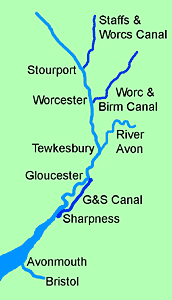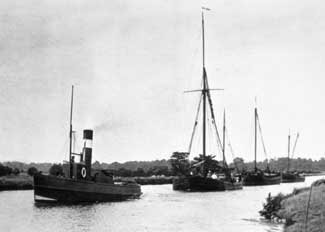 Early
Barge Traffic Early
Barge Traffic
In
the early days of the canal, most of the regular barges using the
canal were based up the River Severn at Worcester or Stourport,
and they usually carried a variety of goods, classed as sundries,
to and from Gloucester or Bristol. The barges were typically 65-70ft
long and 13-15ft wide to suit the barge locks at Stourport, and
they could carry around 60 tons of cargo. Each was crewed by three
or four men who occupied cabins in the bow and stern. (Some vessels
with two masts were referred to as trows, and some without masts
or sails were called lighters, but all three types will be referred
to here as barges.) While on the river and the canal, each barge
was towed by a horse or later by a steam tug. When on the more open
waters of the estuary south of Sharpness, sails were set to give
the barge steerage way, but the crew also made good use of the strong
tidal currents.
Carrying Firms
In
the middle of the nineteenth century, the main carrying firms were
Danks & Co, Pickford & Co and Benjamin Devey, but competition
from the railways forced a series of amalgamations until in 1874,
most of the general cargo barges were brought together under what
became known as the Severn & Canal Carrying Co. In due course,
this company established its main base at Gloucester, where goods
were trans-shipped between barges and inland canal boats.
More Barge Traffic
The
opening of the new dock at Sharpness in 1874 highlighted the need
for barges to carry goods inland from ships that were too big to
pass up the canal to Gloucester. This need was met primarily by
Mousell Chadborn & Co and G T Beard, both firms having depots
at Gloucester and Sharpness. Initially, their barges carried much
grain and timber from Sharpness to Gloucester, with some continuing
up the river to Worcester and Stourport. Later, they also needed
to send barges to Avonmouth to collect imports from ships that were
too big to come to Sharpness. Other barge owners also began picking
up at Avonmouth, and in 1902 the Dock Co started a tug service in
the estuary for this traffic. In the first half of the twentieth
century, the principal barge operators were Severn & Canal,
Mousell Chadborn and G T Beard, and there were other barges that
supplied waterside flour mills. Some larger steel barges without
sails came into service, typically carrying 120 to 180 tons, and
some were fitted with motors.
.jpg) Cargoes Cargoes
Many barges carried
grain and timber from Sharpness and Avonmouth to Gloucester and
further inland. The timber on some barges was piled so high that
a platform had to be provided near the stern so that the steerer
could see over the top. Other inward cargoes collected from Avonmouth
and Bristol included metals, cocoa beans, carbide, strawboard and
tinned food. This last cargo was particularly popular with the bargemen,
as it was easy to arrange for a crate to be damaged in handling
and for some tins to fall out. In 1929, John Harker Ltd began using
tanker barges to collect petroleum products from Avonmouth, and
this traffic became very important over the next thirty years, with
many later barges having motors. Unfortunately, there were few outward
cargoes, and most barges passed down the canal empty.
Going Down the Canal
To
pass along the canal, most of the dry-cargo barges relied on the
regular tug service provided by the Dock Company, and it was common
to have three or four barges in line behind a tug. As empty boats
are difficult to steer, when going down the canal, they were usually
linked by short ropes. Even then it was difficult to get all the
barges through each of the narrow bridge-holes if there was much
cross-wind, so whenever possible a loaded boat was put at the back
of the tow to help to steady it. When a tow was approaching a bridge,
the bridgeman opened one half-span, and it had long been the practice
for a crew member to go ashore to open the other half-span and then
to be picked up again. This difficult and risky operation was not
popular with the men, and in the 1920s the Dock Company began providing
a regular passman to accompany each tow, riding a bicycle along
the towpath and opening and closing each half-span as the tow passed
through.
 Going Up the Canal Going Up the Canal
For loaded barges
going up the canal, it was usual for them to be linked by long ropes,
to minimise the risk of collisions when slowing down. These long
ropes were a popular target for boys swimming in the canal, as they
could reach the lowest part of the sag and so be carried along for
a bit of fun. One bargeman became very skilfull at walking along
the towrope towards the tug in front, but when he had a bet with
the tug skipper that he cold walk all the way, the skipper deliberately
slowed his engine so the bargeman ended in the water. When the tow
neared Llanthony Bridge, Gloucester, the ropes were cast off and
each barge drifted under its own way to its intended mooring place.
A round trip to Avonmouth typically took a few days, but it could
last longer if there was a delay in loading.
A Final Flourish
Barge
movements on the canal reached a peak in the 1940s and continued
high in the 1950s, with much use of motor barges and six new Sabrina
barges (featured on a separate page).
In the 1960s, however, barge traffic was seriously affected by the
growing use of containers, the packaging of timber, road transport
and coastal tankers. As the business diminished, most of the dry
cargo barge owners sold out to the newly formed British Waterways,
and they in turn formally disbanded their fleet in 1969. After this,
the remaining barge movements were mainly those carrying grain to
Healing’s mill at Tewkesbury (featured on another page)
until these finally ended in 1998.
Sources
This
page is based on the Gloucester shipping registers, traffic register
for Diglis Locks 1845, Canal Co records at Kew and the memories
of former barge and tug men. |